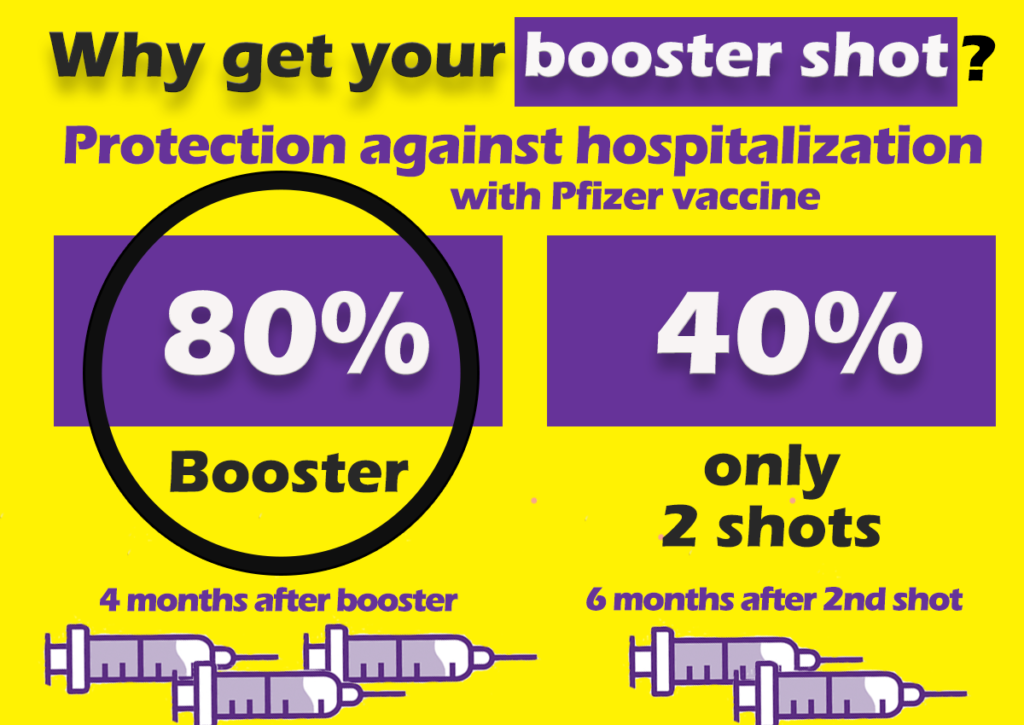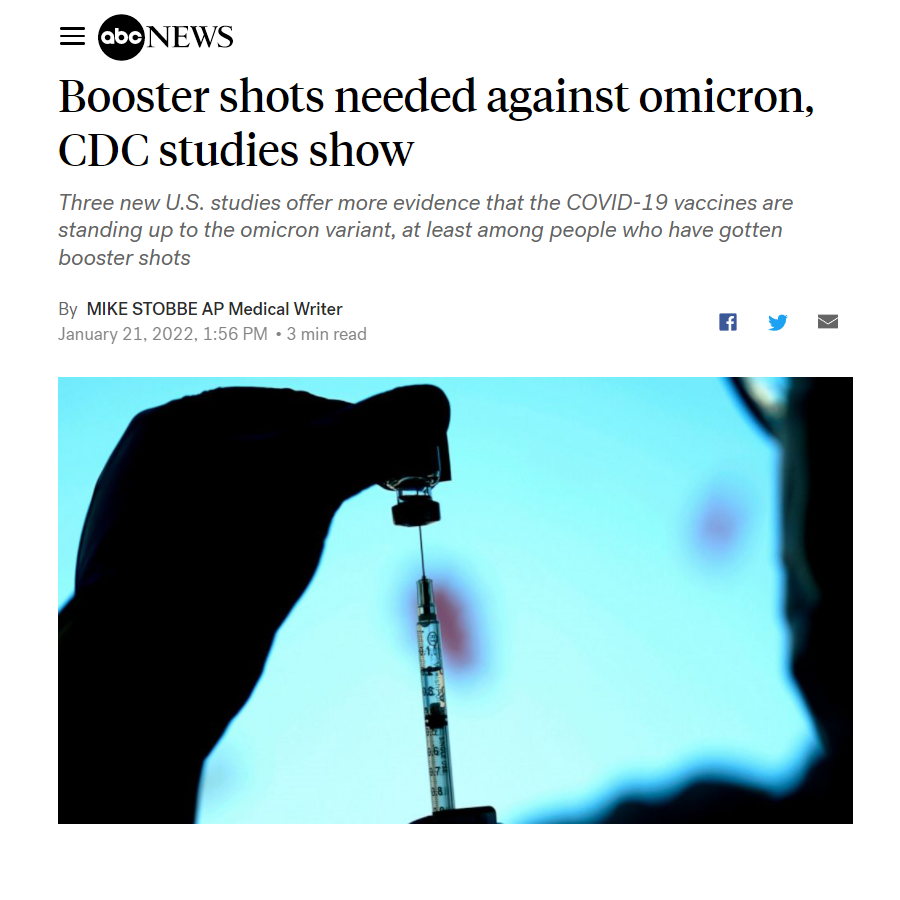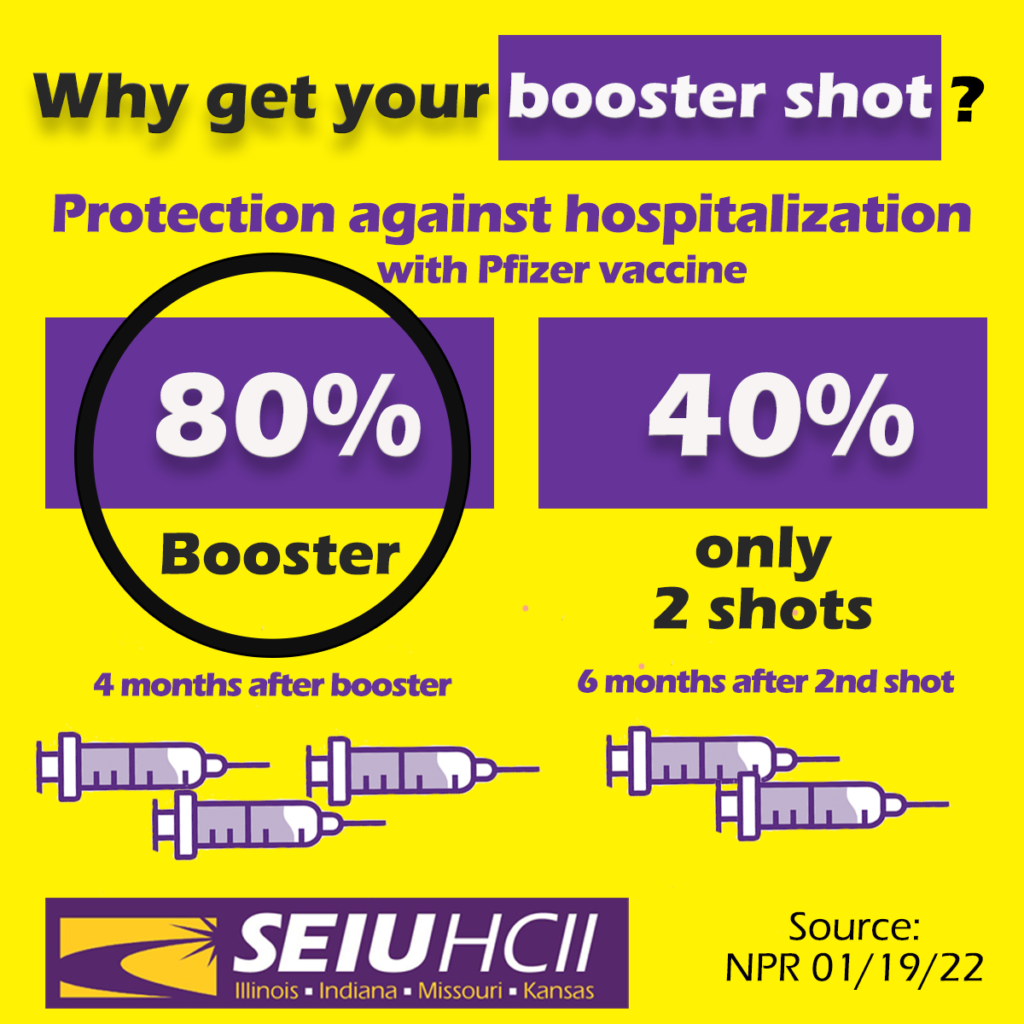Booster Shot Needed Against Omicron


- Although COVID-19 vaccines remain effective in preventing severe disease, recent data suggest their effectiveness at preventing infection or severe illness wanes over time, especially in people ages 65 years and older.
- The recent emergence of the Omicron variant further emphasizes the importance of vaccination, boosters, and prevention efforts needed to protect against COVID-19.

https://www.npr.org/sections/goatsandsoda/2022/01/19/1071809356/covid-booster-omicron-efficacy

Omicron Facts
- Omicron is two to four times more contagious than Delta (https://www.nationalgeographic.com/science/article/is-omicron-really-less-severe-heres-what-the-science-says)
- As of early January, U.S. adults with Omicron were les than half as likely to visit the emergency room, be hospitalized, or put on a ventilator (https://www.nationalgeographic.com/science/article/is-omicron-really-less-severe-heres-what-the-science-says)
- Omicron “appears unable to infect lung cells as efficiently, which in turn makes it less damaging and the symptoms less severe”.
- However, even though Omicron causes less severe disease than its predecessors, the variant’s high transmissibility risks overwhelming hospitals.
- “Because of soaring infection levels, the peak daily hospital admission was higher than during previous surges.” (https://www.nytimes.com/live/2022/01/25/world/omicron-covid-vaccine-tests)
- Nationwide, more than 155,000 people are hospitalized with COVID-19, “well above the record set last winter”. (https://www.npr.org/sections/health-shots/2022/01/13/1072902744/ers-are-overwhelmed-as-omicron-continues-to-flood-them-with-patients)
- COVID-related hospital staffing shortages are further limiting hospital capacity.
- “Stretched to the limit by wave after wave of the virus, health care workers have been quitting at record rates.
- About 3% quit their jobs in November, “a number not seen since the Bureau of Labor Statistics began calculating the data in 2000, as workers leave their positions for better pay, early retirement or to transition to another industry”. (https://www.nytimes.com/interactive/2022/01/21/us/covid-hospitalizations.html)
- “With health care workers out sick with Omicron themselves and the virus compounding pre-existing staff shortages (in part due to burnout from the pandemic), hospitals have less capacity to care for patients than before. And fewer staffed beds available means a smaller number of COVID patients could overwhelm a hospital.” (https://www.nytimes.com/interactive/2022/01/21/us/covid-hospitalizations.html)
- The number of staffed hospital and ICU beds available has steadily been declining since November 2020.
- There are now 4% fewer staffed hospital beds available and 7% fewer staffed ICU beds.
- With huge patient loads, Omicron is worse for hospitals despite the lower overall severity.
- As a result, many patients wait hours to days in the ER to receive treatment both for COVID-19 and other emergent conditions. (https://www.npr.org/sections/health-shots/2022/01/13/1072902744/ers-are-overwhelmed-as-omicron-continues-to-flood-them-with-patients)
- The situation is so dire that Mayo Clinic ER Doctor Casey Clements predicts that the Omicron wave may “break the (healthcare delivery) system in the upcoming weeks”. (https://www.npr.org/sections/health-shots/2022/01/13/1072902744/ers-are-overwhelmed-as-omicron-continues-to-flood-them-with-patients)
- Not just hospitals, but schools and other key employers/service providers are struggling to remain open/operational due to COVID-related staff shortages.
- More than 5,400 schools have reverted to virtual learning since January 3rd (https://www.nytimes.com/2022/01/11/us/schools-covid-testing.html)
- The capacity crunch isn’t limited to schools. According to the Census Bureau, between December 29th and January 10th, approximately 8.8 million workers reported not working because they were sick with coronavirus or caring for someone who was”, which is nearly triple the levels of the previous two weeks. (https://www.washingtonpost.com/business/2022/01/20/workers-out-sick-omicron-census/).
- The Omicron wave is causing acute labor shortages including in industries that are essential to the country’s supply chain (which is in part responsible for inflation). (https://www.washingtonpost.com/business/2022/01/20/workers-out-sick-omicron-census/)
- Only by taking the necessary precautions including masking in indoor public spaces, vaccines/booster shots, etc. can we alleviate the burden on our hospitals, schools, and employers and insure that those infected get the best treatment possible.
